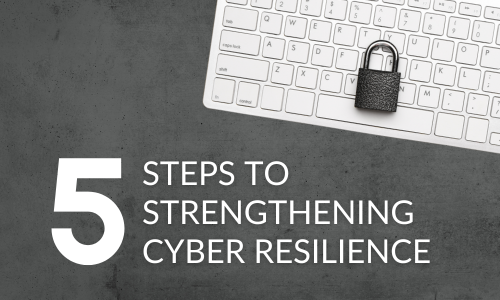
What is Cyber Resilience?
Author: Saul Mulcrow
Release Date: 21/05/2025
Cyber resilience refers to an organisation’s ability to continue operating effectively during and after a cyber attack. It’s not just about prevention, but also withstanding disruption, rapidly recovering systems, and learning from incidents to become stronger over time.
It goes further than traditional cybersecurity, as cyber resiliency recognises that attacks will happen. It prepares businesses to keep critical services running even when systems are compromised - minimising downtime, reducing data loss, and maintaining trust. As threats develop over time, cyber resilience is a strategic response, not just focused on if a threat is blocked, but about how well your business continues when one gets through.
Why Cyber Resilience is Business Critical
As the world is becoming increasingly more digital-first, modern organisations operate in a state of constant digital dependency. From customer-facing systems to internal operations, downtime and data loss can lead to more than just lost revenue, but it can also damage your reputation, reduce customer confidence and also impact compliance regulations, (which could result in fines). Cyber resilience is increasingly recognised as a strategic capability for businesses of all sizes.
Cyber resilience ensures that essential functions continue, whether defending against ransomware, phishing or insider threats, a resilient organisation is one that:
- Responds quickly and decisively to cyber incidents
- Protects its most critical assets
- Maintains continuity across its essential services
- Recovers operations and data swiftly
- Continually adapts to a changing threat landscape
Resilience doesn’t replace cybersecurity, but enhances it. Where cybersecurity focuses on prevention, cyber resilience adds response, recovery and adaption.
The Core Pillars of Cyber Resilience
Achieving cyber resilience requires a coordinated approach across your entire organisation, from the people, processes, and technologies. These are the five foundational pillars that support a mature resilience strategy:
1. Preparation
Preparation is the proactive first step to achieving cyber resiliency, it includes understanding your threat landscape, identifying your critical assets, and building a strong foundation to prevent and mitigate any risks you may encounter. This includes:
- Identify mission-critical systems and high-risk data
- Mapping potential attack vectors
- Engage in regular threat modelling and security assessments
- Conduct regular risk assessments and penetration tests
- Train staff in both cyber awareness and cyber hygiene (you can use tools like KnowBe4 or SoSafe to help with this)
- Implement robust controls and governance over sensitive data (e.g. via Varonis or Imprivata)
- Align security strategy with business continuity planning
2. Protection
While cyber resiliency acknowledges that attacks will happen, robust protective controls are designed to reduce the likelihood and impact of a breach:
- Modern access control via platforms such as Okta and Delinea
- Network segmentation and secure configuration
- Use of secure cloud infrastructure
- Encrypted data storage and secure access controls
- Cloud security posture management (supported by Lacework FortiCNAPP and Cloudian)
- Threat intelligence and monitoring, (supported by Splunk and BlueVoyant)
The aim is to secure every layer, which is: user, device, data, and network.
3. Detection and Response
During an incident, speed is everything, a fast decisive response can make the difference between a minor disruption and a full-scale crisis. Resilient organisations invest in:
- Centralised log monitoring and anomaly detection (SIEM/SOAR tools)
- Real-time dashboards to inform decision making
- Automated alerts and incident playbooks
- Clearly defined roles and responsibilities within incident response teams
- Continuous monitoring and threat detection (Splunk, SecurityScorecard)
- Integration between detection tools and response plans
Wherever an attack comes from, whether it be internal or external, the success depends on how fast and effectively it is contained.
4. Recovery
Recovery is the stage in which resilience really proves its value. The ability to restore operations quickly and securely is central to maintaining stakeholder confidence:
- Implement offsite and immutable backups
- Regular testing of disaster recovery and business continuity plans
- Integration with cloud-native services for fast restoration
- Clearly defined Recovery Time Objectives (RTO) and Recovery Point Objectives (RPO)
- Ensure backup systems are isolated from live environments to prevent reinfection
- Communication protocols to maintain transparency
The best recovery plans assume a breach, then they plan accordingly.
5. Adaption
The threat landscape is constantly evolving, so your defence must too. Cyber resiliency means continuously learning and improving by:
- Conducting post-incident reviews
- Regularly update security policies, tools and technical controls
- Track new vulnerabilities and risks
- Continuously adapt frameworks and tooling
- Embed resilience into lifecycle of products, platforms and operations
Adaption ensures that your security strategy evolves and not just reacts.
Cyber Resilience in Practice
There is a common misconception that cyber resilience is only relevant to large organisations or highly regulated industries. However, resilience is both scalable and critical across all sectors and organisation sizes.
Frameworks such as DORA, NIS2, ISO 27001 and Cyber Essentials have moved beyond a focus on prevention alone. Now, they expect organisations to demonstrate that they can operate during a cyber event, not just avoid one.
Stakeholders have an increasing demand assurance that your business can handle disruptions, making resilience no longer optional and a core part of operational maturity.
Cyber Resilience vs Cybersecurity
Whilst they are both closely related, cybersecurity and cyber resilience have some differences and understanding them is vital in helping develop your cyber strategy. Cybersecurity focuses on prevention - deploying tools such as firewalls, endpoint protection, and access controls to stop threats before they enter your system. It’s a technical discipline, often centered on building strong perimeters and hardening systems against known vulnerabilities.
On the other hand, cyber resilience assumes that no defence is perfect. It prepares the organisation to absorb, respond to, and recover from cyber incidents - whether that be a data breach, ransomware attack, or system outage. Resilience takes a wider, business-centric view, combining technology with strategy, governance and human response. It ensures operations can continue even under attack, and that recovery is well-coordinated and swift.
The two are both complimentary of each other, with strong cyber security forming the foundation, and resilience ensures business continuity and stakeholder confidence when defences are breached. Cyber resilience is not just a safety net, but a strategic necessity for any organisation.
The Benefits of Cyber Resilience
Cyber resiliency brings measurable, strategic benefits:
- Minimised business disruption: Your operations continue even during a breach
- Faster recovery times: With well-tested plans, restoration is quick and secure
- Stronger compliance posture: Many frameworks now demand resilience by design
- Improved Customer Trust: Transparency and control build confidence
- Greater Adaptability: You stay ahead of threats, not just react to them
- Cost Control: Reduces the financial and operational impacts of cyberattacks
How Somerford Can Help Your Organisation Become More Cyber Resilient
At Somerford, we understand the importance of cyber resiliency, how it's a strategic imperative for business continuity and growth. Our partners compliment each other to allow for the development and implementation of a robust resiliency strategy. Our technical experts are also on hand to assist with any problems that you may face in ensuring your company is prepared for any attack. If you wish to find out more about how we can help your organisation become more cyber resilient, contact us.
How Technologies Support Cyber Resiliency
Splunk - Centralised Visibility and Response Coordination
Splunk enables organisations to centralise their data for enhanced visibility, monitoring and investigation. By correlating activity across systems and applying real-time analytics, it helps detect incidents early and orchestrate an effective response. This insight accelerates containment and recovery, enabling security teams to act with confidence and clarity - a core pillar of cyber resilience.
Varonis - Safeguarding Critical Data Through Intelligent Access Control
Varonis helps organisations strengthen their cyber resilience by providing deep visibility into data access, permissions, and usage patterns. It monitors sensitive information across file systems and cloud environments, detecting abnormal behaviour and preventing unauthorised access. By limiting data exposure and enabling rapid threat detection. Varonis reduces the blast radius of potential attacks - supporting faster recovery and more effective incident containment.
Netskope - Enabling Resilient Cloud and SaaS Security
Netskope enhances cyber resilience by providing visibility and control over data and user activity across cloud services, SaaS applications, and the web. Its granular policies help prevent data loss, manage risk from shadow IT, and enforce adaptive access based on user context. This ensures secure cloud adoption without compromising operational continuity or compliance.
HashiCorp - Securing Infrastructure in Dynamic Environments
HashiCorp supports cyber resilience by automating the secure provisioning and management of infrastructure at scale. Through tools that manage secrets, identity, and policy across hybrid and multi-cloud environments, it reduces misconfiguration risks and supports rapid recovery. Secure infrastructure as code helps organisations maintain consistency, control, and speed in the face of disruption.
Confluent - Ensuring Real-Time Data Resilience
Confluent enables cyber resilience by supporting real-time data streaming across systems and environments. Built on Apache Kafka, it allows organisations to decouple services and process data continuously, (even during partial outages or attacks). This supports responsive incident detection, reliable logging pipelines, and continuous service delivery under stress.
Securiti - Enabling Resilient Data Governance and Compliance
Securiti contributes to resilience by helping organisations discover, classify, and protect sensitive data across structured and unstructured sources. Its tools automate compliance workflows, respond to data rights requests, and detect unauthorised data movement. This reduces the risk of regulatory breaches and ensures critical data assets remain protected and recoverable in the event of an incident.
Delinea - Protecting Privileged Access at Scale
Delinea supports cyber resilience by managing and securing privileged accounts, often the most targeted in an attack. It helps enforce least-privilege access, rotates credentials automatically, and monitors privileged activity, making it harder for attackers to move laterally if they gain initial access. Controlling privileged access helps contain threats and protect critical systems during an incident.
Lacework FortiCNAPP - Automating Cloud-Native Threat Detection
Lacework FortiCNAPP supports cyber resilience by continuously monitoring cloud workloads, containers, and infrastructure for misconfigurations and suspicious behaviour. Its automated detection of anomalies helps surface threats that traditional tools might miss, enabling earlier response and limiting attacker dwell time. This proactive monitoring strengthens both prevention and recovery in cloud environments.
mnemonic - Strengthening Resilience with Managed Detection and Response
mnemonic provides managed detection and response capabilities that enhance an organisation’s ability to detect, analyse and respond to advanced cyber threats. By combining threat intelligence with active monitoring, mnemonic helps security teams act quickly and decisively, reducing the potential impact of an incident and improving recovery timelines.
Okta - Resilient Identity and Access Management
Okta plays a key role in cyber resilience through secure identity and access management. By ensuring that only authorised users can access sensitive systems and data, (and adapting access in real time), it helps prevent compromise, even when attackers breach the perimeter. Strong identity control supports continuity and reduces the risk of privilege escalation during an incident.
BlueVoyant - Managed Threat Detection and Continuous Monitoring
BlueVoyant provides continuous monitoring and threat intelligence to help detect and respond to cyber threats in real time. By extending visibility beyond the perimeter, )including third-party and supply chain risks), it supports a broader, ecosystem-focused approach to resilience. This early warning capability reduces time to detection and helps limit business impact.
SoSafe - Strengthening Human Risk Awareness
SoSafe delivers adaptive security awareness training tailored to user behaviour. By simulating realistic phishing attacks and providing targeted learning, it helps reduce the likelihood of successful social engineering attacks. Over time, this supports a more risk-aware culture and reinforces the “human firewall”, a vital layer of any resilience strategy.
KnowBe4 - Embedding a Resilience-First Security Culture
KnowBe4 helps organisations build cyber resilience by improving employee awareness and response to threats. Through interactive training and real-world phishing simulations, it enables users to recognise and respond to suspicious activity. This reduces the risk of human error and supports incident prevention at scale, complementing technical controls and strengthening your frontline defence.
SecurityScorecard - Enhancing Visibility and Continuous Improvement
SecurityScorecard provides external-facing visibility into your organisation’s cyber posture. By offering continuous, real-time assessments across key risk areas - such as application security, endpoint protection, and network exposure. It helps identify weaknesses before they are exploited. This supports both proactive risk management and the ability to adapt quickly, both core principles of cyber resilience.

